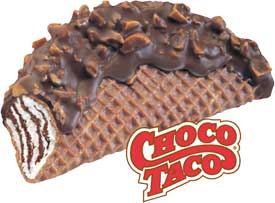On July 25th, the ice cream company Klondike discontinued the Choco Taco, one of their popular novelty ice cream treats. Fans were disappointed. The Choco Taco has been a staple of Klondike’s offerings for almost 40 years now. By all accounts, the product was popular and profitable. So why the decision from Klondike to discontinue it? Economics helps us understand why.

The official statement from Klondike reads:
Firms, just like all economic actors, face scarcity. They only have so many resources (labor, capital, etc.) and they need to decide how to deploy those resources in the most effective manner. When resources are used to produce one item, they cannot be used to produce a different item. Thus, we have the economic understanding of cost: whatever you must give up in order to take an action is the cost. If Klondike wishes to produce a Choco Taco, the cost of the Choco Taco is the monetary price of the inputs plus whatever product could have been produced with those inputs instead. In other words, if Klondike has to choose between the Choco Taco or a Klondike Bar, the cost of producing the Choco Taco is the price of inputs plus one Klondike bar.
The economic understanding of costs as including what one has to give up helps us understand another key economic concept: economic profit. When people hear the word “profit,” they tend to think of accounting profit: monetary revenue minus monetary costs. But economics have a broader conception of profit. Economic profit is total revenue minus total costs. The Klondike Bar in the example above is included in “total costs” for a Choco Taco. If the cost of a Klondike Bar (measured by the foregone revenue of the Klondike Bar if it was produced instead of the Choco Taco) was sufficiently high, then the Choco Taco could have negative profits.
Indeed, it appears this is the case given Klondike’s statement: As demand spiked for all of their goods, the cost of the Choco Taco rose: other goods, potentially earning higher revenue, were sacrificed to produce a Choco Taco. In order to maximize their profit, Klondike decided to discontinue the Choco Taco. Even though the Choco Taco was earning accounting profit, the economic profit turned negative. The company could increase their profit by allocating resources to the marginally more profitable items. As my friend and co-author Nathan Goodman quipped to me: “What would you do for a Klondike Bar? Shift scarce resources away from production of the Choco Taco, apparently.”
The Choco Taco may return. Costs in economics are subjective: they depend on the situation and viable alternatives. Some other firm may purchase the rights from Klondike to produce the product. Some offers are apparently already out there (though it is less clear how serious those offers are). Or, if the costs of producing the Choco Taco fall (that is, the value of the foregone Klondike Bar falls), it may come back. Either way, the firm is led as if by an invisible hand to produce goods that people value more highly.
Jon Murphy received his PhD in economics from George Mason University and is an Instructor at Western Carolina University.


READER COMMENTS
Richard W Fulmer
Aug 7 2022 at 4:48pm
There is still a demand for Choco Tacos, creating an opportunity for someone else to make them or something similar. Choco Chimichangas, anyone?
Thomas Lee Hutcheson
Aug 7 2022 at 6:33pm
But so many other mysteries …. Why the Choco Taco? If it had the smallest margin why not raise the price of the Choco Taco. Or the price of everything to free up production capacity?
Jon Murphy
Aug 8 2022 at 9:32am
The demand is probably pretty close to elastic
Thomas Lee Hutcheson
Aug 8 2022 at 10:39am
So a small increase in the price of all the products would free capacity for the Choco Taco, but reduce total revenue?
Good exam question for a micro course. 🙂
Jon Murphy
Aug 9 2022 at 6:26am
Very probably. The ice cream market is highly competitive with my identical and similar substitutes. They probably cannot raise prices above MC.
Jon Murphy
Aug 9 2022 at 6:54am
I should say “much above MC.” There is market power, but not a ton.
MarkW
Aug 8 2022 at 6:56am
In my city, a group owns two restaurants downtown located next to each other — one an Italian place and the other a steak house. Both are (or were) popular. When Covid hit, they closed the Italian place. Their explanation was that their revenue per customer was much higher at the steakhouse and by closing the Italian restaurant, they were able to double the outdoor seating (extremely valuable during Covid ) for the steakhouse.
Knut P. Heen
Aug 8 2022 at 7:22am
It would be better if they said profit per customer was higher. Steak cost more than pasta. A $10-plate of pasta may be more profitable than a $20-plate of steak.
If capacity was the problem, why wouldn’t they charge the same for the chair/table and let the customer decide whether they wanted steak or pasta at that price?
MarkW
Aug 8 2022 at 9:58am
It would be better if they said profit per customer was higher.
That was assumed — I don’t remember exactly how they worded it.
If capacity was the problem, why wouldn’t they charge the same for the chair/table and let the customer decide whether they wanted steak or pasta at that price?
Because when they made the decision, our governor had banned indoor dining and then later allowed it only with limited capacity. The restaurateurs didn’t need two separate restaurants with two kitchens and staffs to service the outdoor space in front of both businesses.
Besides that, I don’t know of anywhere that the charge-by-the-table model has proved successful long-term.
Knut P. Heen
Aug 8 2022 at 7:11am
There must be something else going on too. Accept all positive NPV projects is the rule. You may do this by renting production capacity from someone else if increasing own capacity is too costly. If increasing own capacity isn’t profitable, the ChocoTaco was only a filler product in the first place (could perhaps have rented out the excess capacity instead).
There may be food safety regulations making it difficult to rent production capacity.
Jon Murphy
Aug 8 2022 at 9:34am
Assumes excess capacity elsewhere. That’s quite unlikely right now
Knut P. Heen
Aug 9 2022 at 9:56am
Raise price first, let the customers tell you what to stop producing.
Corner solutions (terminating a product) are not that common in economics, but very common in linear programming problems. My intuition tells me it is better to continue all products and increase prices to curb demand if capacity cannot be increased. In linear programming problems, one often assumes fixed prices and fixed capacity, and therefore end up with the conclusion that product X must be terminated due to capacity issues. More scarce capacity should lead to higher prices across the entire portfolio of products, not to the termination of one single product. You need large set-up costs and small batches to make termination of a single product efficient.
If there are Choco Taco-lovers around, there is monopolistic competition, and they can charge higher prices from these customers and forget about the price sensitive customers. The entire point of business is to identify hardcore customers who are willing to pay a premium for your product. Competing for price sensitive customers is not helpful if you have capacity issues. You are simply wasting capacity on zero profit operations.
Jon Murphy
Aug 9 2022 at 2:03pm
Customers are already doing that, as evidenced by the fact the Choco Taco isn’t as profitable as other products.
It’s extremely common. Business and product failures are far more common than successes. The fact they are so common is why the profit/loss motive is so powerful.
Capt. J Parker
Aug 8 2022 at 1:01pm
Unfortunately, parent company Unilever has gained a reputation for making decisions on apparently non-economic factors. Let’s hope the Choco Taco decision was an economic one. Plus Unilever still needs to get it’s Ben and Jerrys unit under control.
Jon Murphy
Aug 9 2022 at 6:28am
That could be the case here, but there’s no evidence to suggest the Choco Taco was pulled for non-economic reasoning. Indeed, their statement aligns perfectly with economic reasoning
Comments are closed.